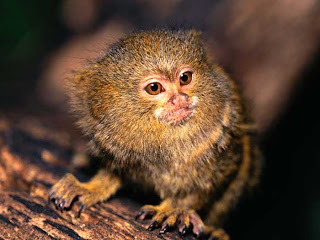 |
| Pygmy Marmoset |
Phylum : Chordata
Class : Mammalia
Order : Primates
Genus : Cebuella
Species : C. pygmaea
Length : 6in (15cm)
Weight : 5oz (140g)
IUCN Status : Least Concern
The ever so adorable Zooborns site alerted me to the birth of twin Pygmy Marmosets at the Perth Zoo, and I just had to look into these tiny, tiny little primates. They are the smallest members of their entire order, with adults measuring barely half a foot long! These diminutive monkeys are found east of the Andes in the upper Amazon Basin.
 |
| Pygmy Marmoset |
Tree gum and sap are the favorite foods of Pygmy Marmosets; they gauge holes into the tree trunks and strip away the bark to get to the gum and sap. They also have specialized incisors to help accomplish this important task, and spend up to 2/3 of their feeding time dealing with trees and sap. Pygmy Marmosets also feed on insects and fruits.
It is difficult to know how many Pygmy Marmosets their are. Their habitat and small size makes it quite difficult to count them. IUCN lists them as being of Least Concern, though their population is decreasing due to habitat loss and collection for the pet trade. In the wild their major predators are birds of prey. They live about a decade, and up to twenty years in captivity.
Hello,
ReplyDeleteI am doing a school project and was wondering what the exact population of a Pigmy Marmoset is. I can not find it anywhere! Quick response would be appreciated. Thank you!
I was not able to locate an exact population count, but the IUCN has some numbers regarding population density http://www.iucnredlist.org/apps/redlist/details/41535/0
ReplyDeleteI want to know when the pygmy marmosets became vulnerable
ReplyDelete